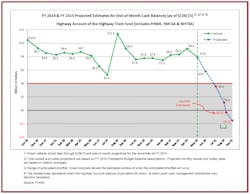Senate committee introduces bipartisan 6-year highway bill
The Senate committee charged with developing the highway portion of the federal surface transportation authorization has rolled out a six-year, $350 billion plan that includes $13.5 billion for a national freight program. That’s the good news.
The catch is that the legislation unveiled Tuesday, the Developing a Reliable and Innovative Vision for the Economy (DRIVE) Act, budgets $90 billion more than the Highway Trust Fund can support and the House and Senate, to say nothing of Democrats and Republicans, can’t agree on how to make up for that shortfall. And, without a solution or yet another extension, federal funding for highways and transit runs out in just over a month.
“When you look at the things that need to be done, you can’t do it on short-term extensions,” said Sen. Jim Inhofe (R-OK), chairman of the Senate Environment and Public Works (EPW) Committee. “I keep trying to tell my conservative friends and those who want to say we can’t spend money on a big highway bill that this is one area where we can.”
The case for Inhofe, a leading conservative himself, is simply that extensions end up costing 30 percent more “off the top,” he explained at a Capitol briefing.
Ranking member Sen. Barbara Boxer (D-CA) called the bipartisan occasion “a really good day in United States Senate” and expressed hope for continued cooperation as the deadline nears.“This was a negotiation that wasn’t easy,” Boxer said. “This is what you call an emergency, and this committee has once again stepped in.”
Four years ago, EPW took the lead on legislation that became the current highway bill, MAP-21, and worked last year to develop a replacement program that went nowhere because of the funding issues and the looming elections.
And, she noted Tuesday, three other Senate committees still have roles to play. But the July 31 deadline, the failing trust fund, and the need by states for a reliable federal funding structure—to say nothing of the state of the disrepair of the nation’s roads and bridges—make action “essential.”
Sen. David Vitter (R-LA) chairman of the EPW Subcommittee on Transportation and Infrastructure, called the bill “a win-win for everyday Americans and our economy,” and called on the Senate to make passing it a bipartisan priority.
Sen. Tom Carper (D-DE), senior member of the infrastructure subcommittee, compared short-term extensions to trying to drive across the country using only 5 gallons of gas at a time.
“We have the ability to fill up the tank, and we can make this trip a whole lot faster and a lot smoother—and by doing that we can really drive this economy,” Carper said.
Along with moving people, the bill addresses the importance of moving goods “where they need to go, when they need to go,” Carper added, agreeing with Inhofe on the importance of transportation to U.S. exports, and the importance of exports to local businesses.
"The new freight program is going to be good," Inhofe said. "No state is an island. We have to one, big unified United States."
Indeed, the DRIVE Act features a freight program to help states deliver projects that promote the safe, efficient, and reliable transportation of consumer goods and products. The more than $2 billion annual allotment is on top of existing formula programs.
Other highlights include:
- Long-term funding certainty for state and local governments to support multi-year transportation project investments;
- Increased funding for existing core transportation formula programs to provide states and local governments with a strong federal partner;
- Targeted funds for major projects of high importance to a community, a region, or the nation;
- Greater efficiency in the project delivery process through improved collaboration and reduced duplication;
- Increased funding priority on the Interstate System, the National Highway System, and bridges at risk of funding shortfalls;
- Greater transparency on the use of federal funds to show taxpayers where their infrastructure dollars are being spent and reinforce public trust; and
- Support for innovative financing tools that allow state and local governments to leverage federal funds for transportation projects and maximize investments, particularly in rural areas where such tools were previously unavailable.
Business, the construction industry, trucking and labor support a multi-year program.
“Getting beyond the gridlock that has been strangling federal investment in the nation’s mobility is going to take bipartisan cooperation and leadership,” American Road & Transportation Builders Association (ARTBA) President & CEO Pete Ruane said. “Now it’s time for the Senate Finance and House Ways & Means committees to do theirs and provide the path forward with a sustainable revenue stream for the Highway Trust Fund. Transportation investment is a core federal responsibility. It’s time to transcend politics and do the right thing for America.”
Transportation Sec. Anthony Foxx likewise urged Congress to act on a long-term bill.
“The state of our nation’s infrastructure is not a partisan talking point; it is a problem facing all Americans. So I am encouraged that Members of Congress are asking the tough questions about how we will find solutions together,” Foxx said.
The Transportation department has also resumed its Highway Trust Fund ticker, above at left, with updated projections on the account balance and when payments to the states will have to be curtailed.
In a business meeting Wednesday, and with little debate, EPW unanimously recommended the bill to the full Senate.
About the Author
Kevin Jones 1
Editor
Kevin has served as editor-in-chief of Trailer/Body Builders magazine since 2017—just the third editor in the magazine’s 60 years. He is also editorial director for Endeavor Business Media’s Commercial Vehicle group, which includes FleetOwner, Bulk Transporter, Refrigerated Transporter, American Trucker, and Fleet Maintenance magazines and websites.


